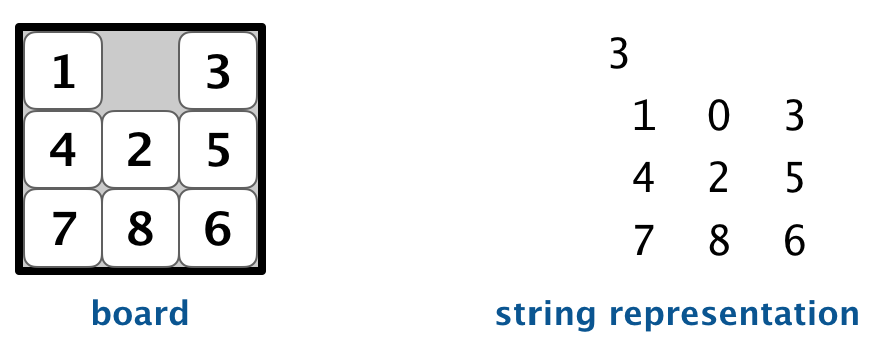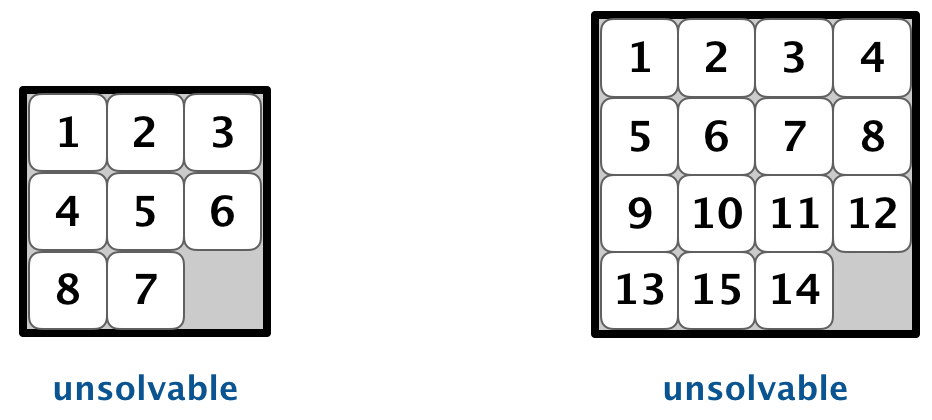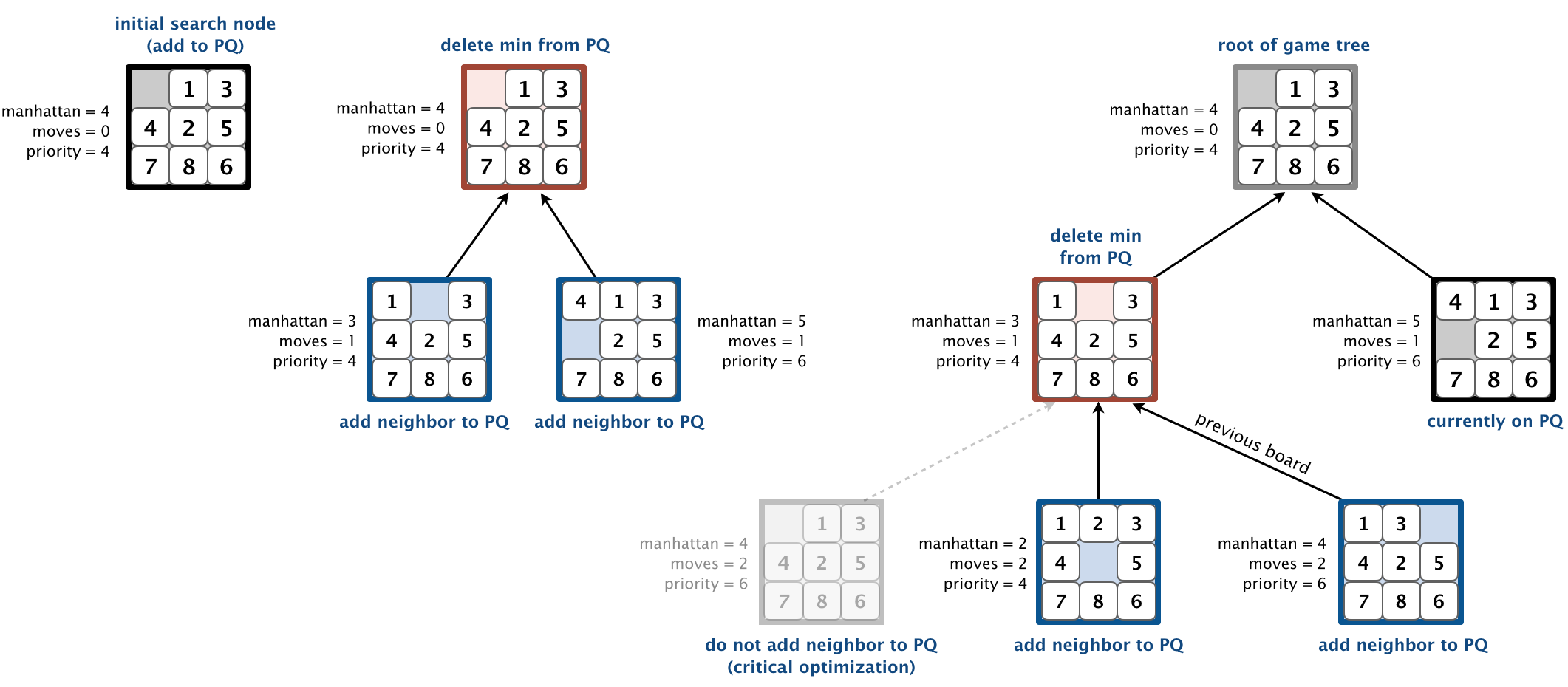
| COS 226 8 Puzzle |
Programming Assignment checklist |
Write a program to solve the 8-puzzle problem (and its natural generalizations) using the A* search algorithm.
The problem. The 8-puzzle is a sliding puzzle that is played on a 3-by-3 grid with 8 square tiles labeled 1 through 8, plus a blank square. The goal is to rearrange the tiles so that they are in row-major order, using as few moves as possible. You are permitted to slide tiles either horizontally or vertically into the blank square. The following diagram shows a sequence of moves from an initial board (left) to the goal board (right).

Board data type.
To begin, create a data type that models an n-by-n
board with sliding tiles.
Implement an immutable data type Board with the following API:
public class Board {
public Board(int[][] tiles) // create a board from an n-by-n array of tiles,
// where tiles[row][col] = tile at (row, col)
public String toString() // string representation of this board
public int tileAt(int row, int col) // tile at (row, col) or 0 if blank
public int size() // board size n
public int hamming() // number of tiles out of place
public int manhattan() // sum of Manhattan distances between tiles and goal
public boolean isGoal() // is this board the goal board?
public boolean equals(Object y) // does this board equal y?
public Iterable<Board> neighbors() // all neighboring boards
public boolean isSolvable() // is this board solvable?
public static void main(String[] args) // unit testing (required)
}Constructor. You may assume that the constructor receives an n-by-n array containing a permutation of the n2 integers between 0 and n2 − 1, where 0 represents the blank square. You may also assume that 2 ≤ n ≤ 32,768.
String representation.
The toString() method returns a string composed of n + 1 lines.
The first line contains the board size n; the remaining n lines contains
the n-by-n grid of tiles in row-major order,
using 0 to designate the blank square.

Tile extraction.
Throw a java.lang.IllegalArgumentException in tileAt() unless
both row and col are between 0 and n − 1.
Hamming and Manhattan distances. To measure how close a board is to the goal board, we define two notions of distance. The Hamming distance betweeen a board and the goal board is the number of tiles in the wrong position. The Manhattan distance between a board and the goal board is the sum of the Manhattan distances (sum of the vertical and horizontal distance) from the tiles to their goal positions.

Comparing two boards for equality.
Two boards are equal if they are have the same size and their corresponding tiles are in the same positions.
The equals() method is inherited from java.lang.Object,
so it must obey all of Java’s requirements.
Neighboring boards.
The neighbors() method returns an iterable containing the neighbors of the board.
Depending on the location of the blank square, a board can have 2, 3, or 4 neighbors.

Detecting unsolvable boards. An efficient approach for detecting unsolvable boards is described in the next section.
Unit testing.
Your main() method must call each public method directly and
help verify that they works as prescribed (e.g., by printing results to standard output).
Performance requirements.
In the worst case, your implementation must support
size() and tileAt() in constant time;
the constructor, hamming(), manhattan(), isGoal(),
equals(), toString(), and neighbors()
in time proportional to n² (or better);
and
isSolvable() in time proportional to n4 (or better).
Detecting unsolvable boards. Not all initial boards can lead to the goal board by a sequence of moves, including these two:

Remarkably, we can determine whether a board is solvable without solving it! To do so, we count inversions, as described next.


It turns out that the converse is also true: if a board has an even number of inversions, then it is solvable.

In summary, when n is odd, an n-by-n board is solvable if and only if its number of inversions is even.

That is, when n is even, an n-by-n board is solvable if and only if the number of inversions plus the row of the blank square is odd.
A* search. Now, we describe a solution to the 8-puzzle problem that illustrates a general artificial intelligence methodology known as the A* search algorithm. We define a search node of the game to be a board, the number of moves made to reach the board, and the previous search node. First, insert the initial search node (the initial board, 0 moves, and a null previous search node) into a priority queue. Then, delete from the priority queue the search node with the minimum priority, and insert onto the priority queue all neighboring search nodes (those that can be reached in one move from the dequeued search node). Repeat this procedure until the search node dequeued corresponds to the goal board.
The efficacy of this approach hinges on the choice of priority function for a search node. We consider two priority functions:
To solve the puzzle from a given search node on the priority queue, the total number of moves we need to make (including those already made) is at least its priority, using either the Hamming or Manhattan priority function. Why? Consequently, when the goal board is dequeued, we have discovered not only a sequence of moves from the initial board to the goal board, but one that makes the fewest moves. (Challenge for the mathematically inclined: prove this fact.)
Game tree. One way to view the computation is as a game tree, where each search node is a node in the game tree and the children of a node correspond to its neighboring search nodes. The root of the game tree is the initial search node; the internal nodes have already been processed; the leaf nodes are maintained in a priority queue; at each step, the A* algorithm removes the node with the smallest priority from the priority queue and processes it (by adding its children to both the game tree and the priority queue).
For example, the following diagram illustrates the game tree after each of the first three steps of running the A* search algorithm on a 3-by-3 puzzle using the Manhattan priority function.

Solver data type.
In this part, you will implement A* search to solve n-by-n slider puzzles.
Create an immutable data type Solver with the following API:
public class Solver {
public Solver(Board initial) // find a solution to the initial board (using the A* algorithm)
public int moves() // min number of moves to solve initial board
public Iterable<Board> solution() // sequence of boards in a shortest solution
public static void main(String[] args) // test client (see below)
}
Implementation requirement.
To implement the A* algorithm,
you must use the
MinPQ
data type for the priority queue.
Corner case.
Throw a java.lang.IllegalArgumentException in the constructor if the argument is
null.
Unsolvable boards.
Throw a java.lang.IllegalArgumentException in the constructor if
the initial board is not solvable.
Test client. Your test client should take the name of an input file as a command-line argument and print the minimum number of moves to solve the puzzle and a corresponding solution. The input file contains the board size n, followed by the n-by-n grid of tiles, using 0 to designate the blank square.
% more puzzle04.txt 3 0 1 3 4 2 5 7 8 6 % java-algs4 Solver puzzle04.txt Minimum number of moves = 4 3 0 1 3 4 2 5 7 8 6 3 1 0 3 4 2 5 7 8 6 3 1 2 3 4 0 5 7 8 6 3 1 2 3 4 5 0 7 8 6 3 1 2 3 4 5 6 7 8 0 |
% more puzzle3x3-unsolvable.txt 3 1 2 3 4 5 6 8 7 0 % java-algs4 Solver puzzle3x3-unsolvable.txt Unsolvable puzzle |
Two optimizations. To speed up your solver, implement the following two optimizations:

Board constructor; save it in an instance variable;
and return the saved value as needed.
This caching technique is broadly applicable: consider using it in
any situation where you are recomputing the same quantity many times and
for which computing that quantity is a bottleneck operation.
Challenge for the bored. Implement a better solution which is capable of solving puzzles that the required solution is incapable of solving.
Deliverables.
Submit the files Board.java and Solver.java (with the Manhattan priority).
We will supply algs4.jar.
Your may not call any library functions other than
those in java.lang, java.util, and algs4.jar.
You must use
MinPQ
for the priority queue.
Finally, submit a readme.txt
file and answer the questions.